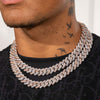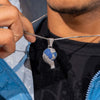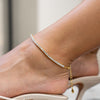Is Moissanite a Real Diamond? Understanding the Key Differences
Is Moissanite a Real Diamond? Understanding the Key Differences
In the world of fine jewelry, diamonds have long been celebrated for their unmatched brilliance, durability, and timeless allure. However, as more people explore alternatives to traditional diamonds, a common question has emerged: Is moissanite a real diamond? At Adamans, we specialize in moissanite chains that combine elegance with sustainability, and we believe in the importance of educating our customers about the unique qualities of moissanite and how it compares to diamonds.
In this blog, we’ll take a closer look at what makes moissanite distinct, its similarities to diamonds, and whether it can be considered a true diamond alternative.
What is Moissanite?
Moissanite is a beautiful, durable gemstone with a unique origin. Discovered by Nobel Prize-winning chemist Henri Moissan in 1893, moissanite was first identified in a meteor crater. Due to its rare natural occurrence, nearly all moissanite on the market today is lab-created. These lab-created stones have become increasingly popular due to their affordability, durability, and dazzling sparkle, making them an attractive alternative to traditional diamonds.
Key Characteristics of Moissanite:
- Hardness: Moissanite ranks 9.25 on the Mohs scale, close to a diamond’s perfect score of 10, meaning it’s highly resistant to scratching and ideal for daily wear.
- Brilliance: Moissanite is known for its impressive “fire” (a rainbow-like sparkle) due to its high refractive index, making it distinct from diamonds.
- Sustainability: Since moissanite is lab-created, it’s environmentally friendly and free from concerns about conflict sourcing, making it an ethical choice.
What Makes a Diamond Unique?
Diamonds, naturally formed over millions of years, have long been cherished for their strength, rarity, and symbolism. Their natural origins and unique optical properties make them highly sought-after for jewelry, especially engagement rings. Diamonds are either mined from the Earth or, more recently, grown in laboratories to provide a sustainable and affordable option.
Key Characteristics of Diamonds:
- Hardness: Diamonds are the hardest known natural substance, scoring a 10 on the Mohs scale. This makes them exceptionally durable and well-suited for daily wear.
- Clarity and Brilliance: Diamonds have a unique brilliance due to their single refractive nature, giving them a clear, white sparkle rather than the colorful “fire” found in moissanite.
- Symbolism: Diamonds have traditionally symbolized eternity, luxury, and commitment, which has made them a popular choice for special occasions like engagements.
Is Moissanite a Real Diamond?
The short answer is no—moissanite is not a real diamond. Although they may look similar to the untrained eye, moissanite and diamonds are distinct minerals with different compositions, optical properties, and sources.
-
Composition:
- Diamonds are composed of pure carbon and form naturally in the Earth under high-pressure conditions. Lab-grown diamonds share the same chemical composition but are created in controlled settings.
- Moissanite, on the other hand, is made from silicon carbide, a compound that gives it a unique structure and appearance.
-
Brilliance:
- Moissanite has a higher refractive index than diamonds, resulting in a more colorful sparkle. This “fire” is one of the distinguishing features of moissanite and makes it visually appealing in its own right.
- Diamonds exhibit a classic, white brilliance due to their single refractive property, which many consider timeless and elegant.
-
Rarity:
- Natural diamonds are rare, contributing to their high price and desirability.
- Moissanite, being lab-created, is more accessible and affordable, making it a popular choice for those seeking high-quality jewelry without the high price tag.
Why People Confuse Moissanite with Diamonds
While moissanite is not a real diamond, there are several reasons why people may confuse the two gemstones:
- Appearance: Moissanite and diamonds look remarkably similar, especially in well-cut stones. Moissanite can mimic the clear brilliance of a diamond, making it a visually appealing alternative.
- Durability: Both gemstones are incredibly durable, suitable for everyday wear, and resistant to scratching.
- Value and Affordability: Many consumers are attracted to moissanite because it offers the look and durability of a diamond at a fraction of the cost.
Why Choose Moissanite Chains from Adamans?
At Adamans, we believe in offering jewelry that combines beauty, quality, and ethical sourcing. Our moissanite chains allow you to enjoy the luxury of a sparkling, durable gemstone without the high price or environmental impact associated with traditional diamonds. Here’s why moissanite is an ideal choice for our chains:
- Stunning Sparkle: Moissanite’s high refractive index means that it shines brightly in all lighting conditions, making our chains a standout accessory.
- Durability: Our moissanite chains are crafted to withstand daily wear, so you can enjoy your jewelry without worry.
- Affordable Luxury: With moissanite, you can experience the look of high-end jewelry without overspending, allowing you to invest in multiple pieces or larger stones.
- Ethically Sourced: All of our moissanite is lab-created, ensuring that your jewelry choice aligns with values of sustainability and responsibility.
FAQs About Moissanite and Diamonds
1. Can people tell the difference between moissanite and diamond?
- To the untrained eye, moissanite and diamonds can look very similar. However, a jeweler or someone with a keen eye might notice moissanite’s rainbow sparkle, which is different from the classic white sparkle of a diamond.
2. Does moissanite lose its sparkle over time?
- No, moissanite retains its brilliance and fire over time. With proper care, it will continue to shine as brightly as the day you bought it.
3. Is moissanite a good alternative to diamond for engagement rings or fine jewelry?
- Yes! Moissanite offers a beautiful, durable, and affordable alternative to diamonds. Its high quality and affordability make it a great option for fine jewelry, including engagement rings and chains.
4. Can moissanite be passed off as a diamond?
- While some people may use moissanite as a diamond substitute, reputable jewelers will clarify the gemstone’s identity. At Adamans, we believe in transparency and proudly celebrate the unique qualities of moissanite.
Moissanite: The Gemstone of Choice for Modern Jewelry Lovers
Though moissanite isn’t a real diamond, it stands on its own as a stunning and sustainable alternative. For many jewelry enthusiasts, moissanite offers the perfect blend of brilliance, durability, and affordability, making it an ideal choice for everyday wear and special occasions alike. Its ethical sourcing and minimal environmental impact further enhance its appeal to modern consumers who want their jewelry to reflect their values.
Conclusion
When choosing between moissanite and diamonds, it’s essential to consider what matters most to you in a gemstone. Diamonds are a traditional, timeless choice with a distinct sparkle and unmatched hardness, but they come with a high price tag and ethical concerns. Moissanite, on the other hand, offers a unique brilliance, durability, and affordability that make it an excellent option for those seeking a beautiful, ethical alternative.
At Adamans, we’re proud to offer a range of moissanite chains that capture the beauty and brilliance of this extraordinary gemstone. If you’re interested in exploring a gemstone with unparalleled sparkle and a modern twist, we invite you to browse our collection. Discover why moissanite is more than just a diamond alternative—it’s a gemstone with its own story, brilliance, and lasting appeal.































